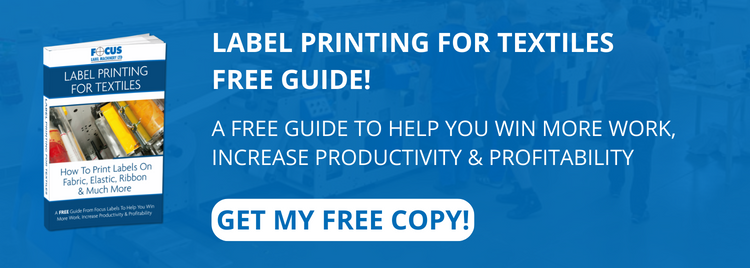
At first glance, flexographic label printing may appear to have a high level of complexity. However, the printing process has several core features that apply regardless of the product or label material. This article will show you how to understand your customer’s print requirements and produce product labels in accordance with your brief. A more in-depth discussion of the technical aspects of label printing is included in our free eBooks: Guide to Printing on Textiles, and The Ultimate Guide to Flexo-Printing.
1. Label Design
The design of the label is critical, as this will communicate what your customer’s product is all about. It will also determine what approach you need to take while managing the print run. Effective label design results from knowing exactly what your customers want as well as knowing which printing method will deliver the highest quality labels within a budget.
The aesthetics of a label are best identified by the design team, whether this is provided as part of your service or in conjunction with the customer or advertising design bureau. At their most basic, product labels need to contain enough information to inform the end user, but not so much as to overwhelm them. Once a label design has been completed and all desired elements in place, effects can be added as required.
Many printing effects can be applied to add impact to customer labels. Embossing and the hot & cold foil process can both add a unique look and feel to add perceived value or quality.
Colour matching is another consideration. You will either need spot or process colour for customer labels. Spot colour involves the printing of only one, two or three single colours which may be a specific colour shade or corporate brand colour. Full colour printing blends cyan, magenta, yellow and black to make unique shades or photo quality images.
2. Choosing The Right Process
Labels are produced by many methods such as Offset, letterpress, Silk Screen, Flexo, Foil & digital systems. Choice of production can depend on the labels application, on roll or sheet, hand applied or automatic line, substrate type, volume and even the effect the end user is trying to achieve. In some cases more than one process will be required to produce the desired label Image & impact the client is looking for.
3. Accounting For Bleed
If you want your customer’s product label to have a border, you will need to consider bleed. Bleed refers to any text or graphics that extend to the label’s edge. If your label has no margins and the image extends beyond its edges, it has ‘bled off’. Bleed is important, especially if the labels you’re printing contain a lot of text, as not having set margins can result in your text being unreadable.
4. Bar Code & Variable Data
Along with bleed, it’s important to ensure there is enough room on the label for a bar code. The bar code will make products traceable and more secure, in addition to making it easier for customers to purchase. Where variable data needs to be included this information may be included during the print run or applied off line or even as the label is applied to the product. Thermal Transfer & Ink jet technology are often part of packing line as print & apply equipment adding this variable information before entering the retail chain.
5. Substrate
You must ensure that the machinery you use to print labels can handle printing on the customer’s desired substrate. The selection of substrate will often be dictated by the end application and the environment the product will be used. For example a label applied to Shampoo will need to withstand water, whilst another product may be stored outside in direct sunlight or even freezer temperatures.
6. Adhesives
Like the substrates Label material manufacturers provide a variety of adhesives with different properties for different applications. Permanent & Peelable adhesives are at the extremes and you need to carefully consider the labels final application when selecting an adhesive.
Free Guide to Flexo-printing
We have covered flexographic printing methods and technologies in greater depth in our new eBook; The Ultimate Guide to Flexo-Printing. To access your FREE copy today, simply click here.





